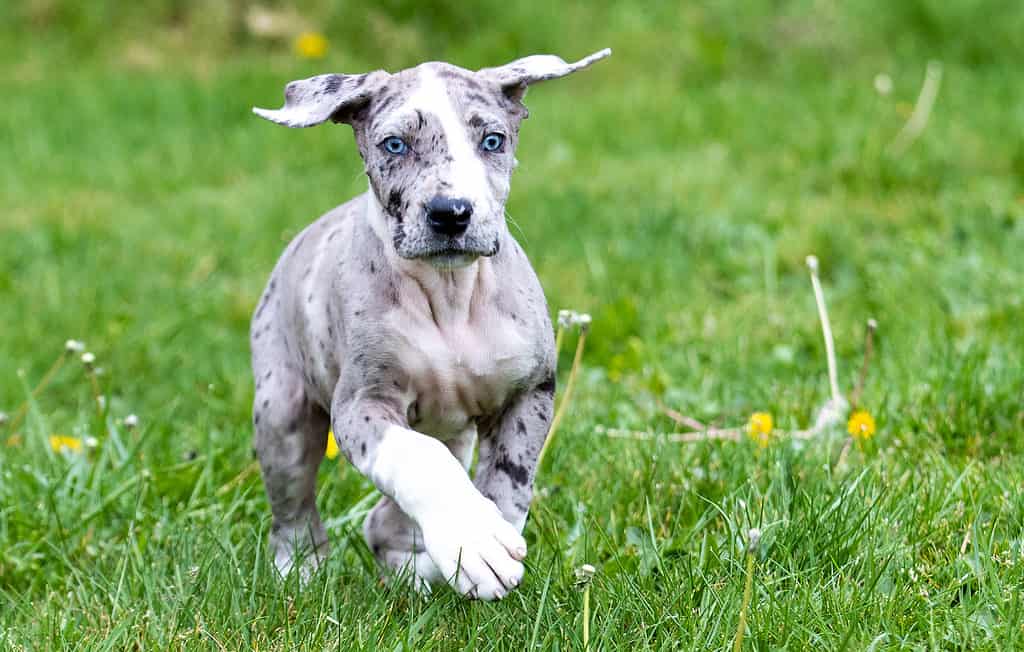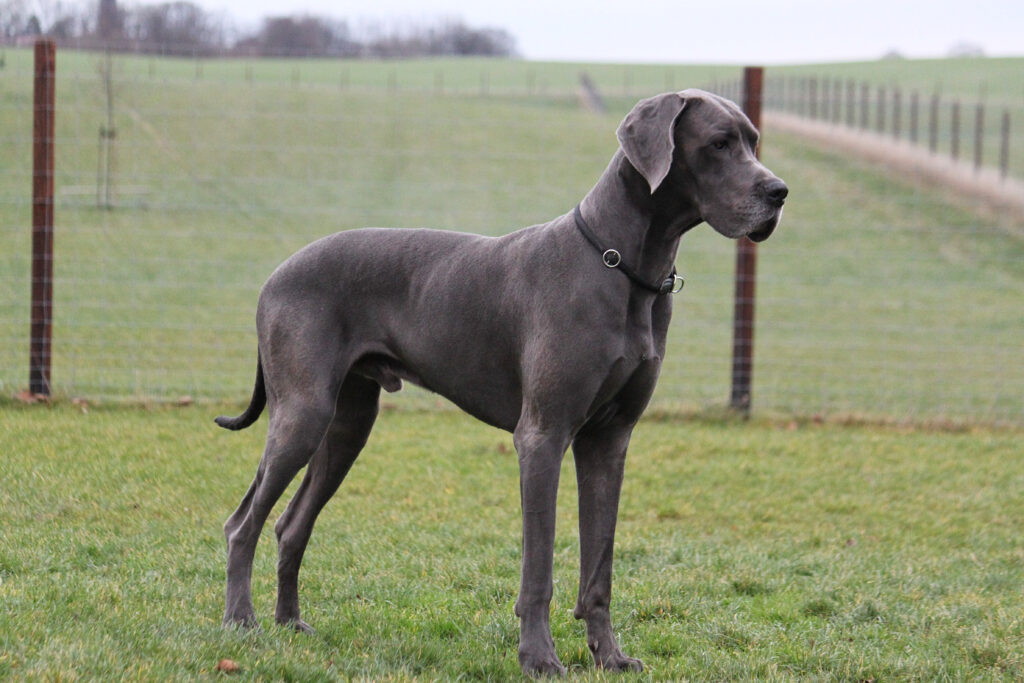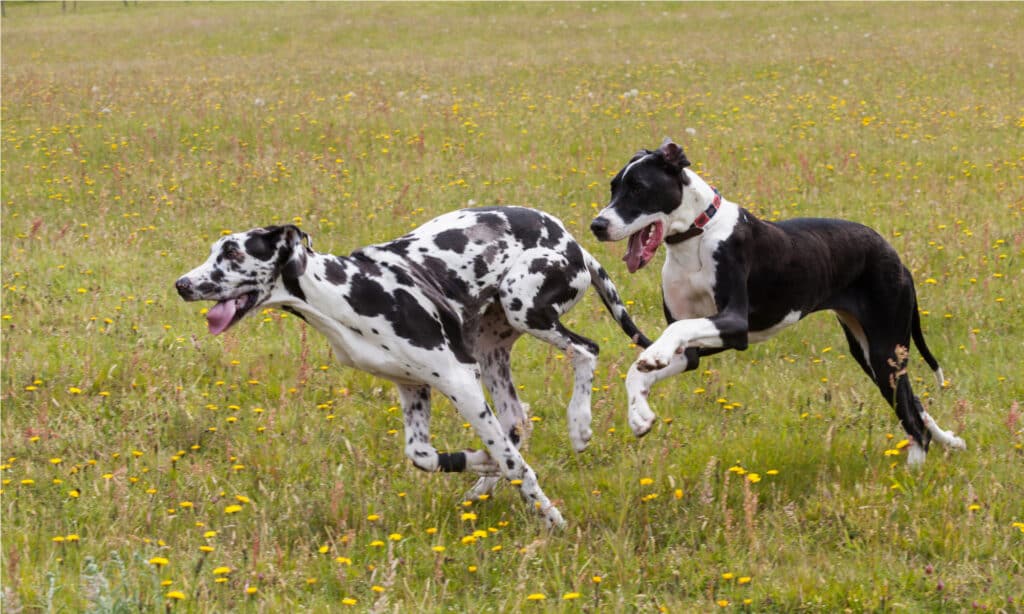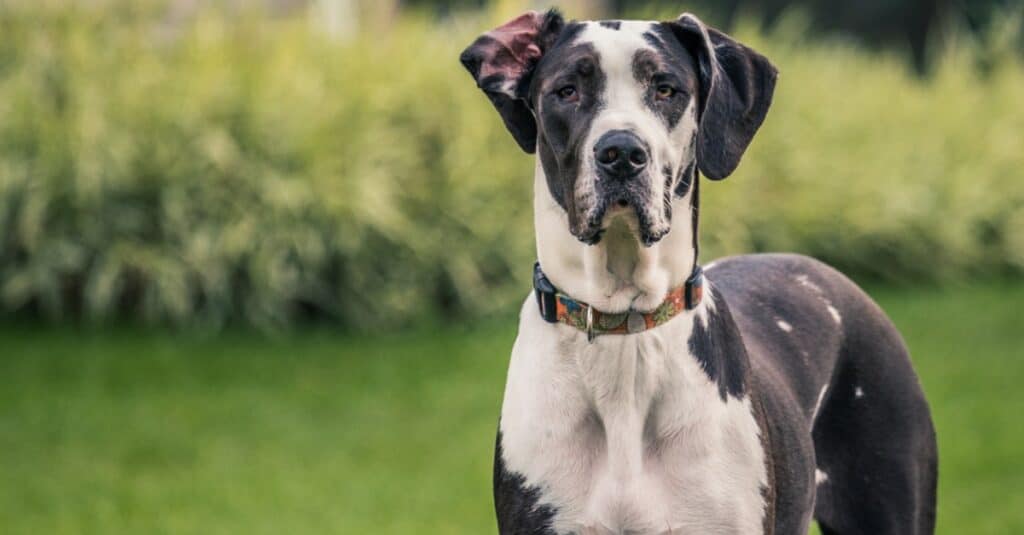
You’re likely expecting to pay more for a Great Dane throughout their lifetime than, say, a Shih Tzu or Chihuahua. These giant dogs go through a lot of food, need higher doses of medications, and can be prone to health problems. But just how much does a Great Dane cost?
The average Great Dane owner spends $3000 or more a year for their dog. This includes food, essential supplies, and routine veterinary bills. However, unexpected costs are likely to present themselves and can raise your costs considerably.
In this article, we’ll break down the things you can expect to pay for throughout your Great Dane’s lifetime with estimated costs, from the price of adopting a Great Dane puppy to common health problems.
How Much Does a Great Dane Puppy Cost?

Great Dane puppies range from $500-$3000+ depending on where you purchase them.
©MPH Photos/Shutterstock.com
A Great Dane puppy from a breeder costs around $1000-$3000 dollars, with most breeders falling somewhere in the middle of this range. Rescue Great Danes typically cost $500 or less.
Those charging very little for Great Dane puppies are likely puppy mills, which churn out a large number of litters per year and exist only for profit.
Higher costs don’t always mean the breeder is better, however. It can mean they’re trying to profit as much as possible and may keep their own costs low to the dogs’ detriment.
Reputable breeders will have the recommended genetic health tests completed and easily accessible to you for both parents. They typically have waitlists and won’t have a puppy on hand to give you today.
They’ll ask questions about your home, family, and lifestyle to ensure their puppies go to good homes. They’ll also expect you to ask questions–so don’t be afraid to do so!
If your breeder isn’t transparent when answering questions, gives inaccurate information, or isn’t knowledgeable about the breed, they’re likely a backyard breeder–someone who doesn’t have the care or knowledge to breed responsibly. Some backyard breeders are well-intentioned, but their mistakes can have a harsh impact on their dogs’ lives.
Other Factors That Influence the Purchase Price of a Great Dane
Other factors that can influence the cost of your Great Dane puppy include lineage, location, and which individual breeder you buy from.
Reputable breeders tend to charge middle-ground prices, though not always. Dogs with award-winning parents or ancestors may cost more as the breeder has more demand for their puppies.
Breeders who put more effort into care and training than most will often charge more as well to compensate for their time. For instance, some breeders may choose to keep the puppies longer to socialize them and train basic tasks, while others may even train them for service work.
The breeders’ location will also play a role, as those with a high cost of living will likely charge more for their puppies than those in lower-cost areas.
Cost of Vaccination and Other Medical Expenses for Great Dane

Because they’re so large, Great Danes can be expensive to bring to the vet.
©iStock.com/Credit:BiancaGrueneberg
Puppy vet visits can add up quickly. I recommend having money set aside for your puppy’s first year before bringing them home.
It’s also a good idea to purchase pet insurance for your dog, particularly if you don’t have a large savings account for them. Emergency visits, in particular, can get very pricey, and it helps to not have to worry about money in a crisis.
Some insurance companies will also partially cover routine visits, but often they won’t pay much of the overall cost.
Below, we’ll dive into the average prices for Great Dane veterinary care. Please keep in mind that rates can vary based on your area and your vet.
Vaccines – $25-75 per vaccine
Vaccine costs will vary depending on which vaccines you and your vet choose to give your dog. I highly recommend following your veterinarian’s guidance here, as they know what’s common in your area and can assess your dog’s individual risk level.
The only vaccine required by law in most states is rabies, but there are also core vaccines recommended for every dog and several others your pup might need depending on their risk factors.
Important dog vaccines include:
- Rabies – first vaccination at 12-16 weeks, booster a year later, then boosters every three years.
- DHLPP (vaccinates against distemper, hepatitis, leptospirosis, parainfluenza, and parvo) – given at six, eight, 12, and 16 weeks. Another booster is given a year later, then once every one to three years.
- Bordetella – given at six to eight weeks and 10-12 weeks, then once every six to 12 months.
- Leptospirosis – two doses two to four weeks apart, then a yearly booster.
- Canine Influenza – two doses two to four weeks apart, followed by a yearly booster.
- Lyme – two doses three weeks apart, followed by yearly boosters.
- Coronavirus – two doses two to four weeks apart, followed by a yearly booster. This is not the same coronavirus as COVID-19.
- Rattlesnake vaccine – two doses 30 days apart, followed by a booster once every six to 12 months.
Spay or Neuter Surgery – $150-$600
Spaying or neutering your Great Dane comes with a host of behavioral and health benefits and is recommended as soon as your pup is old enough.
Most veterinarians will recommend waiting until your Great Dane is fully grown to avoid complications that can arise from spaying or neutering too early, such as joint conditions. There are also risks to having the surgery too late in life, so follow your vet’s guidance.
Surgery for Great Danes tends to be on the pricier end due to their size. Spays for female dogs tend to cost more than neuters for male dogs as they’re more invasive procedures.
The ASPCA has a list of low-cost spay and neuter programs for those who cannot afford the procedure from your average veterinarian.
Surgical Gastropexy – $500-$1500 (when non-emergent)
Surgical gastropexy is a surgery done to prevent bloat (GDV) in dogs who are high-risk, like Great Danes. It’s commonly done during the spay or neuter surgery, though some veterinarians prefer to do it separately.
It will likely cost less if done alongside a spay or neuter because you won’t have to pay for anesthesia and other medications more than once.
Bloat is the highest cause of death in Great Danes, so I highly recommend speaking to your veterinarian about a gastropexy to prevent it in your dog. The surgery has high success rates and can literally be life-saving.
The surgery involves adhering the stomach to the dog’s right side. This prevents it from flipping around inside the body, which is the deadly aspect of bloat.
When done to prevent bloat, a gastropexy will cost around $500-$1500. Emergency gastropexies for dogs who have bloat are much more expensive, and your dog is less likely to survive the procedure.
Check-Ups – $50-$250 per visit
Healthy dogs should have yearly wellness visits throughout their young adulthood and should see a veterinarian once every six months as seniors. If your Great Dane gets sick, they may need more frequent vet trips.
What you pay will depend on what your vet charges as an exam fee, which routine tests you choose to run (such as bloodwork), and whether your vet finds anything wrong during the visit.
Parasite Prevention Medications – $200-$500
Dogs should be on parasite-prevention medications year-round to prevent them from picking up parasites such as fleas, ticks, and heartworm.
Great Danes need the largest dose of parasite preventatives since they’re giant breeds. What you pay will depend on which parasites you need the medication to cover, the age and size of your dog, and the brand you choose.
Dental Care – $300-$700+
Most veterinarians recommend yearly professional dental cleanings, though your dog may not need them this often if their teeth are healthy and you brush their teeth at home.
Prices can range widely from what I’ve seen, but you should expect to pay more for a Great Dane than for smaller dogs because they need higher doses of anesthesia and other medications.
Sick Vet Visits – costs range widely
Your Great Dane will also need to visit the veterinarian when they are sick. It’s important to keep a watchful eye on your dog and bring them to the vet if they show symptoms of illness or aren’t acting like themselves. Often, slight changes in personality are one of the first things you’ll notice.
Prices for sick visits to the vet range so widely it’s impossible to give even a range. A simple ear infection may cost a couple of hundred dollars to treat, while going to the emergency vet for bloat will put your bill well into the thousands.
Whether or not you have insurance will also make a difference here, as the insurance company may compensate you for part or all of your bill (so long as the illness wasn’t pre-existing before you bought pet insurance).
Common Great Dane Health Conditions
Below are a few health conditions that Great Danes are especially prone to and approximately what each can cost. Keep in mind that different vets charge different rates, and the cost of living in your area will also play a role.
- Hip dysplasia – $1,500-$7,000 for surgery on one hip.
- Allergies – $20-100 for medication, $20-$200 for allergy shots, and $1,000+ for allergy testing. Your dog may need allergy medication for life. They may not need all of the treatments listed–these are just examples.
- Bloat (GDV) – $1,500-$7,500 for an emergency gastropexy. Bloat is an emergent condition that kills 30% of dogs even with treatment.
- Hypothyroidism – $50-150 for testing and $20-$50 per month for medication.
- Cardiomyopathy – $1000+ for diagnostics and $50-$150 a month for medications.
Reputable breeders will screen for some of the above, which greatly reduces your dog’s chances of developing those illnesses. However, there’s no way to stop a dog from ever getting sick, so it’s vital to be prepared before it happens.
Cost of Food and Supplies for Great Danes

Great Danes require more food and larger items than most other dogs due to their size.
©Claire Plumridge/Shutterstock.com
Food
Food costs can vary widely depending on what you feed your dog. Kibble is the cheapest, while canned and raw diets cost more. (Please note that the FDA and American Veterinary Medical Association recommend against raw diets for pets, however.)
On average, you’ll likely pay around $2000 a year to feed your Great Dane. This is assuming you feed a veterinarian-recommended diet that consists of kibble only.
Of course, you can also spend much more than this. I’ve spoken to Great Dane owners who pay several hundreds of dollars a month to feed their pups and those who have paid much less as they’re buying the food they can afford.
Through my research on my own pets, I’ve found that I trust brands that comply with WSAVA guidelines the most. These brands complete research to ensure their foods are healthy, and their recipes are formulated by certified veterinary nutritionists. They’re also the brands most recommended by veterinarians.
Initial Purchases $50-$600
Initial purchases you’ll need to make before adopting your Great Dane include:
- Food and water bowls
- Brush
- Nail clippers or dremel
- Crate (optional)
- Collar
- Harness (optional)
- Leash
- A crash-tested dog seatbelt or sturdy crate for in the car (technically optional but highly recommended!)
These can range in price depending on brand, quality, and how many you buy. While your dog technically only needs one of all of these, you may purchase multiple cute bowls or decide you’d prefer two crates for different areas of the house.
Or, your dog might be the type to chew up their leashes, and you may end up buying many throughout their lifetime.
Quality items cost more but are more likely to last throughout your pup’s lifetime. Cheaper items are more likely to need replacing over time.
You may pay as low as $50 on initial purchases for your Great Dane, and there’s not truly an upper limit. The average cost for all of the above will be a few hundred dollars.
Repeat Purchases – costs range widely
The following are repeat purchases you’ll make throughout your Great Dane’s lifetime:
- Toys
- Collars, harnesses, and leashes
- Treats
- Dental care (dog toothpaste, toothbrushes, dental chews, and treats)
- Chewed household items
The costs of these also vary widely depending on brand, quality, and your own spending habits. I’ve spent a ton on dog toys and treats, but buy cheap collars and rarely need to replace them. You may find that your Great Dane treats their toys so well that they don’t need replacing, but you enjoy buying them lots of cute collars and leashes.
On the last point, your Great Dane may not destroy anything or only chew a few cheap pairs of shoes. On the other end of the spectrum, some people have to replace whole couches when their giant-breed puppy chews them up!
Household Purchases – costs range widely
Lastly, you may decide to purchase things around the house because of or for your Great Dane. This includes things like furniture covers, car seat covers, fencing, and more.
Some people will spend nothing on items like this, while others may pay thousands if they’re fencing a large backyard, for instance.
How Much Does It Cost to Insure a Great Dane?

Pet insurance is highly recommended, as it can save your dog’s life in a crisis.
©iStock.com/Earl-Wilkerson
Pet insurance can be a real lifesaver if you don’t have a large savings account for your Great Dane. They’re prone to some very expensive health problems!
Pet insurance costs range from $20 to $100+ dollars a month.
Typically, cheap pet insurance covers very little, and expensive plans have more coverage. Great Dane insurance will cost more than many other breeds due to their high risk of bloat, which is very costly.
It’s best to purchase pet insurance as soon as you adopt your Great Dane. If you wait until they’re sick, pre-existing conditions won’t be covered.
Read the fine print carefully to ensure you know what you’re buying, and shop around for different estimates before committing to a plan!
Unlike human health insurance, pet insurance doesn’t usually cover routine vet appointments. Instead, it pays out in case of an accident, sickness, or emergency.
Be sure to check how your insurance pays vet bills as well. Many require you to pay the vet initially, then compensate you for a percentage (or all) of the bill once you submit a claim. Very few will pay the vet upfront–so if you need this, be sure to shop around.
How Much Does It Cost to Train a Great Dane?
Training for your Great Dane can be free if you can handle their training at home. It depends on how much you’re willing to learn on your own, and if you encounter behavioral problems you need help with.
You might choose to pay for a puppy training class, which is a great way to learn the basics for a couple of hundred dollars. If you need one-on-one training or want your pup professionally trained for more complicated activities like dog sports or service work, you may pay well into the thousands.
Remember to only use force-free methods for training your Great Dane. When looking for a trainer, ask questions before you pay.
Walk away from anyone who uses aversive training methods or refers to “dominating” your dog or being the “alpha” or “pack leader.” These are red flags and often indicate that they believe in the disproven dominance theory of dog training.
Lifetime Costs of a Great Dane
That’s everything you can expect to spend on your Great Dane! But what are the total lifetime costs?
This varies considerably. However, let’s assume you don’t pay for insurance or training and you don’t have any hefty vet bills throughout your dog’s lifetime (which is, sadly, pretty unlikely!).
If you’re very frugal and very lucky, your Great Dane can cost roughly $4000 in your first year.
Paying for all recommended vaccines, health insurance, and a preventative surgical gastropexy could add another $3000 or more in the first year, assuming costs fall into the middle of the spectrum for these things.
In the following years, you’ll be paying for vaccines less frequently and won’t need a spay or neuter or a surgical gastropexy, so this will reduce your costs. You also won’t be paying the initial adoption fee again.
However, your dog will need professional dental cleanings as an adult and, into their senior years, will need more frequent vet appointments. You can expect to spend an average of around $3000 a year on your Great Dane.
Great Danes live an average of 7-10 years. So, you can expect to pay at least $21,000-$30,000 throughout their lifetime–possibly more if you forego insurance and end up with a hefty vet bill, you buy expensive items for your pup, or they develop a long-term health condition. Professional training and grooming can also add up quickly.
I hope this article has helped you to budget for your Great Dane and learn more about the costs of dog ownership. Remember that unexpected costs are extremely likely throughout your dog’s lifetime and can drastically increase the amount you’ll need to spend.
Thank you for reading! If you have feedback on this post, please contact the AZ Animals editorial team.
The photo featured at the top of this post is © MPH Photos/Shutterstock.com
Ready to discover the top 10 cutest dog breeds in the entire world?
How about the fastest dogs, the largest dogs and those that are -- quite frankly -- just the kindest dogs on the planet? Each day, AZ Animals sends out lists just like this to our thousands of email subscribers. And the best part? It's FREE. Join today by entering your email below.
Thank you for reading! Have some feedback for us? Contact the AZ Animals editorial team.






